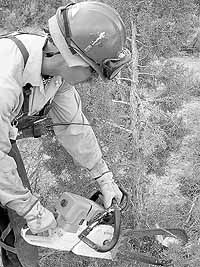| Kurt Kause of Moab trimming trees in a three-mile BLM area north of East Carbon |
Back in 1996 all it took was one lightning strike just a few miles north of East Carbon to begin a fire that raged through 1000 acres and threatened the east Carbon County community.
Part of the reason the fire burned so quickly was the large amount of dead juniper brush that littered the high desert area. These junipers had been knocked down by bulldozers and chains back in the 1960’s as ranchers cleared the land to plant grass for their cattle.
Since then trees have sprouted up and now range upwards from eight to 10 feet. But as these trees and the pinyons grow back, the dead trees still fill the underbrush area and all of this is a fire danger. Heavy winds that can fuel the flames are prevalent and as the area enters the fifth year of drought the range is prime for another fire.
Because of this the area just north of East Carbon was one of several areas targeted by state and federal agencies recently to create a 300 foot sweep of land to protect the town in case of another fire.
Other targeted areas include the Price Recreation area west of Highway 6 and the roadside along the highway in Price Canyon as well.
The group that identified communities at risk is known as Southern Utah Interagency Fuels Committee and is comprised of personnel from Forest and Park Service, BLM and state government. They are all working together to make sure priorities are in line. The local group is working with communities in the four-county area of Carbon, Emery, Grand and San Juan counties.
One mile of the identified area near East Carbon is state land and this area has been completed. The BLM project, under the direction of Hal Stevens, fuel specialist for the BLM here in Price, will continue throughout the summer. The entire project is about three miles in length.
“The shade break won’t stop a fire,” explains Stevens, “but it will slow it up.”
His crews, along with a crew from Moab, were working in that area last Thursday. They are cutting the lower limbs of the juniper trees and along with these branches, and the dead branches, they make large piles. These will be burned the first snowfall of the season this winter. They also cut down trees in areas where it is the thickest, leaving about 30 feet between each tree.
Mandated by congress, the project is called Wildland Urban Interface. Stevens explained that because of the effectiveness of the fire crews the agencies have created their own problems.
“Fire crews do not let natural fires burn themselves out and without the natural burns more and more dead wood piles up in the forests,” says Stevens. “When there is a large fire it is nearly impossible to stop.”
Besides the juniper trees there are also large groves of pinyon trees, which have been struggling the past few years in eastern and southern Utah. Because of the drought, a beetle larva knows as Ips builds up inside the trees and the majority of pinyons are diseased and will eventually die. In years when there is more moisture the sap will push out the eggs, but with the prolonged drought the beetles continue their destruction.
According to Heather O’Hanlon, fire mitigation education specialist from Moab, the project is “very successful.” She explained that this is a national project and Utah has been a leader in getting the program into gear and rolling along.

